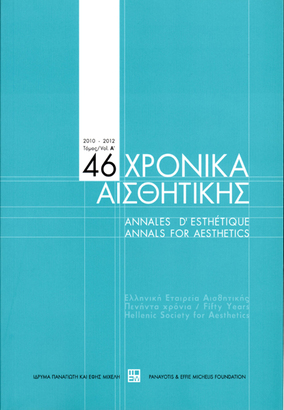Το χρώμα σαν στοιχείο της αρχιτεκτονικής μορφής
Part of : Χρονικά αισθητικής : ετήσιον δελτίον της Ελληνικής Εταιρείας Αισθητικής ; Vol.Ε, No.1, 1966, pages 137-153
Issue:
Pages:
137-153
Parallel Title:
Colour as an element of the architectural form
Author:
Abstract:
We may say that, in our visual world, colour is the «structural material» of architectural forms.The objects of our visual experience are not undifferentiated sensuous stimulations. We perceive every visual form, and this involves a mental process in which colours are the primary data given to our senses.The «image», the visual manifestation of an architectural work, gains meaning by reference to certain unchangeable human properties resulting from man’s physical existence: his body, its movements, and the need for stability and equilibrium.This reference concerns three basic relationships between man and architectural form, viz., (a) measurement, i.e., the comparison of physical sizes, (b) movement; the fact that an architectural composition corresponds to the characteristics of man’s movement is apprehended as the satisfaction of the need for «freedom and definition of visual movement», and (c) equilibrium, which is apprehended as the visual balance of forms.In order to comprehend how colours act in architectural forms, it is important to know their «modes of appearance» and their main «attributes». With these attributes, colours are described as they appear to be for human apprehension and not as physical phenomena. An examination of the qualities of colours shows that the colours of an architectural work do not merely «paint» its form, but actually constitute it, since any visual form is the meaningful interpretation of all the visual elements which are given for its apprehension.The satisfaction of the basic human need for «freedom and definition of visual movement» depends on colours and their different degree of insistence. Every colour is a visual barrier for the eye and a point of reference from which visual transition takes place to another point. Colours define the flow of visual movement in space and thus express how the volume of space «fits» into the contour of masses.Since apprehension of the dimensional relationships of a space is based on the articulation of visual movement within it, colours play a leading role in the measurement process, as they divide space into smaller units and then lead back from them to the whole by creating a continuity of different conditions of visual definition.The measurement process is affected chiefly by the ability of colours to unite and separate the various elements of an architectural form and thus relate one element to the other and to the whole.Colours represent visual forces. Equilibrium in all the energies involved by the colours of an architectural form satisfies the basic human need for visual equilibrium.Visual equilibrium is a «qualitative» relationship between man and the architectural form, since equilibrium in the sensuous energies implied by the form leads to aesthetic appreciation. When our visual impressions and, generally, our sensations do not balance, the form is not considered aesthetically pleasant. This apparent equilibrium necessitates the neutralization of visual forces. The neutralizing forces are supplied by man reacting through his intellect.The basic relationship between architectural form and man refers to relationships founded on visual communication with architectural work.Rules determining the correspondence between the colour composition of the form and its relationships with man cannot be laid down.The degree of this correspondence depends on how closely the designer has approximated this ultimate reality, which human variances prevent from ever being attained.
Subject:
Subject (LC):
Notes:
Ανακοίνωση που έγινε στην Ελληνική Εταιρεία Αισθητικής, στις 12 Μαΐου 1966




